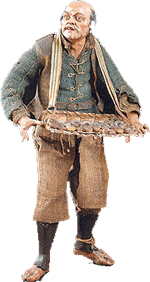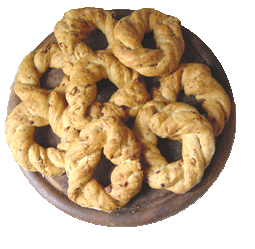O’ tarallo profuma: è chiatto e tunno,
nasce a Napule, e va pe tutt’o munno.
Che tene? Pepe, ‘nzogna e past’e pane.
‘O panettiere ‘a forma ‘a fa ch’e mane:
ncoppa ce mette ‘a mandorla, ch’è doce
e nforna tutte cose: s’adda coce.
Po’ sta ‘o tarallo ‘e Puglia: il tarallino,
fatto con l’olio. E’ assai più piccolino,
ha pochi grassi (lui di strutto è privo):
si sposa bene con l’aperitivo.
Tarallino e tarallo so’ speciale:
tra loro songo amice, e non rivale.
Si (arrassusia!) succede nu’ casino,
fernesce sempe a tarallucci e vino!
Whence arises the word Tarallo, it is not known with certainty. So the hypotheses abound: some say from the Latin "torrere" (toast), and those from the French "Toral" (dryer). Referring to its round shape, but some think tarallo resulting dall'italico "tar" (wind) or from Old French "danal" (pain rond, round bread).
The most credible theory, however, that wants to descend tarallo dall'etimo greek "daratos", "sort of bread." If it is not clear from which arises the tarallo etymology, but it is known where it grows: under a cloth that favors rising. And especially when you know the tarallo has spread, and why.
Matilde Serao, who wrote both of Naples, Naples and Tarallo, in his famous work "The Belly of Naples", describes the famous "warehouses", the popular areas near the harbor, teeming with a population undernourished and thus famished . The Belly of Naples was full of people, but the belly of those people were surprisingly empty. To fill it, by the end of 700, they tried (and often succeeded) the bagels.
Where there is almost nothing, nothing is destroyed, and everything is created. So even the bakers would not dream of throwing away the "sfriddo", ie the scraps of dough with which they had just prepared the bread to bake.
These scraps of dough adding a little 'to' nzogna "(pork fat: Italian, lard, pork fat) and lots of pepper, and with their skilled hands reduced the dough into two strips. Then the twisted between them, gave to this braid to form a donut, and inside the oven, together with the bread.
At 800 the tarallo "'nzogna and pepper" was enriched with another ingredient that is still embedded in it: the almond. No one knows who has submitted the first to Tarallo, but whoever it was, deserves our gratitude: the flavor of the almond is in fact a marriage with pepper.
The Tarallo, another son of the prolific creativity of Naples, he did good to all: the baker, who used the remaining dough with little trouble: and the people, that little money (given the low production costs) if they bought . The Tarallo was a true blessing for the bag, but also for the palate (the lard and pepper, and then the almonds, they give an excellent flavor), and survival: the fat that is in fact contains a lot of calories.
Due to its characteristic of poor food, the tarallo went like hot cakes, from which the bottom (and baking) is derived. It is consumed in the taverns, where the wine was accompanied by often very low value. On one hand, higher consumption (the pepper's thirst), but on the other by reducing the negative effects of otherwise empty stomachs.
The specialists say go tarallo eaten soaked in sea water. Today, this refinement should be avoided, given the state of our seas, but also in the past, this use must have been responsible for many gastroenteritis.
The bagels are a whim around Naples. It 'still a classic buy to Mergellina, placed in kiosks on the promenade, and devour them while walking with Vesuvius on one side and the other Posillipo.
Once the bagels Neapolitans do not expect customers at kiosks, or bakeries, as now, to meet him in the street.
The "tarallaro" was a characteristic figure. With his basket on his back, pounding relentlessly the city to sell bagels to passersby. Today is gone, but that disappears in reality often survives in the language: even now, to indicate a person without a voice, tossed to and fro by events and forced to constantly bustling, it says "I think 'to or basket of tarallaro! "
In his endless laps, the tarallaro gave voice: "taralle, taralle Cavere!" The word "Cavere" should not be read in Latin, with the accent on the second "e" (Cavere), and thus it means "be careful , do. " Stay away from bagels? God forbid!
It should be read in the Neapolitan Cavere, hot. Taralle Cavere means precisely "hot bagels."
And hot, must be strictly in order to emit their characteristic fragrance and entice people to buy. It was for this, and not for reasons of hygiene (at that time we cared little), that the tarallaro covered his precious cargo with a blanket.
Since then, Tarallo has come a long way, or better, continued to make, but this time on its own legs. The export basket was passed: at first outside the borders of Campania, and then (since is a recent, still embryonic) in foreign markets.
All this was possible because the Tarallo saw change their type of consumption: from genre staples, (once you could even define a life-saving food), the tarallo Neapolitan ('nzogna and pepper) has become a commodity stimulant, a privileged young target.
Today, his death (that is the best way to eat it) is indeed with the beer, less alcoholic wine which accompanied the first. In breweries and pubs frequented by children, bagels and beer currently form a duo well-knit, and particularly requested.
Thanks to these new consumer habits, it is currently the tarallo well at the supermarket, at least in the best chains. Well packaged, vacuum-packed, with the indication: "heat before use." You do not need the microwave: just a simple radiator to release the little 'heat that just because the free suet back into the milk, and almond give their best. Incidentally, the examination of the almond is a good test to evaluate the freshness of Tarallo. If it's still pretty hard, and is fragrant, everything OK. If it is soft and does not emit any odor, it means that Tarallo is old.
The combination with the beer brought into our homes tarallo: it is used increasingly as a "snack". To comply with (and promote) this new trend, food companies have put on the market tarallo small size, hence less calories, and easier to sell.
Obviously, tarallo small, almond small: for this purpose are used almonds broken (which previously had no place on tarallo), or almonds smaller selected for this purpose (discarded in the processing of the set).
Below a certain extent, however, the tarallo Neapolitan not able to go (nor would want to): in order to make the characteristic donut with almonds, a certain size is still required.
Besides feeding, the bagels are also in the language space. Unequivocally is the Neapolitan way of saying: "If you tirassen 'na sport'e taralle, it fell a nun' nterra". Translation: If you lanciassero a basket of bagels, do not anyone would fall to the ground. Why?
Tien'e ccorna flaws! (Translation: Because your wife an affair with another man).
It 'easy to imagine that the recipient of this sentence does not take well. But never fear: the tarallo "Ciacca", and the medical Tarallo. It 'damage, but repairs them: it is always thanks to him that peace is made, and everything ends
"To tarallucci and wine."
Quest 'other word was born in taverns, and has a mildly derogatory sense: the Tarallo, already poor food, is reduced to the rank of "taralluccio" to mean a composition a bit' surface of a dispute. A "caring" facade of way.
Today this expression, which is also exported, as Tarallo, throughout Italy, but is simply meant to achieve a happy ending.
For taralluccio Tarallo then by definition means that the Neapolitan and small format at most and not, as some believe the tarallino.
The term "tarallini 'it is the variety from Puglia.
The tarallino Pugliese has spread to Italy (and abroad) before the Neapolitan.
Already appearance, looks very different from his Neapolitan cousin, smaller, smooth and of smaller caliber, is made with olive oil, and no almonds. Often, you adding fennel seeds and / or chili.
The Apulian tarallino probably comes from "daratos" greek: from "kind of bread" from which even the greek tarallo Naples. But then he took a different route, thanks to the oil of the board of Apulia who has become a fundamental ingredient. .
The Apulian tarallini have always been small as now. Its small size, associated with a low calorific value (do not contain lard!), Have made them highly suitable as an aperitif. And as an accompaniment to drinks. It should be remembered that - ironically - Italy, which up until not many years ago was hunger, is currently the world's leading .... consumption of aperitifs.
This type of drink is commonly paired with snacks: pretzels, peanuts, and - indeed - tarallini Puglia. Smaller, lighter, and therefore highly suitable for this purpose.
The export of tarallino Pugliese, now consolidated, was born out of this use.
Its production is not particularly complicated, moreover: the absence of '"plot" manual pasta, tarallino Pugliese did not need a sophisticated craftsmanship.
From the above, it is not surprising that the tarallino Pugliese, consumed as (and with l ') drink, has "opened" the way to the production of Neapolitan tarallo small, eager to fit in this gluttonous market segment.


